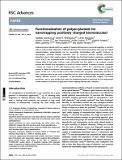Por favor, use este identificador para citar o enlazar a este item:
http://hdl.handle.net/10261/203356COMPARTIR / EXPORTAR:
 SHARE
BASE SHARE
BASE
|
|
| Visualizar otros formatos: MARC | Dublin Core | RDF | ORE | MODS | METS | DIDL | DATACITE | |

| Título: | Functionalization of polyacrylamide for nanotrapping positively charged biomolecules |
Autor: | Davydova, Nadejda; Rodríguez Martínez, Xabier; Blazquez, Carlos; Gómez Rodríguez, Andrés CSIC ORCID; Perevyazko, Igor; Guasch, Judith; Sergeev, Vladimir; Laukhina, Elena CSIC ORCID; Ratera, Immaculada; Veciana, Jaume CSIC ORCID CVN | Fecha de publicación: | 16-may-2019 | Resumen: | Engineering new materials which are capable of trapping biomolecules in nanoscale quantities, is crucial in order to achieve earlier diagnostics in different diseases. This article demonstrates that using free radical copolymerization, polyacrylamide can be successfully functionalized with specific synthons for nanotrapping positively charged molecules, such as numerous proteins, through electrostatic interactions due to their negative charge. Specifically, two functional random copolymers, acrylamide/acrylic acid (1) and acrylamide/acrylic acid/N-(pyridin-4-yl-methyl)acrylamide (2), whose negative net charges differ in their water solutions, were synthetized and their ability to trap positively charged proteins was studied using myoglobin as a proof-of-concept example. In aqueous solutions, copolymer 1, whose net charge for a 100 chain fragment (QpH 6/M) is −1.323 × 10−3, interacted with myoglobin forming a stable monodisperse nanosuspension. In contrast, copolymer 2, whose value of QpH 6/M equals −0.361 × 10−3, was not able to form stable particles with myoglobin. Nevertheless, thin films of both copolymers were grown using a dewetting process, which exhibited nanoscale cavities capable of trapping different amounts of myoglobin, as demonstrated by bimodal AFM imaging. The simple procedures used to build protein traps make this engineering approach promising for the development of new materials for biomedical applications where trapping biomolecules is required. | Versión del editor: | http://dx.doi.org/10.1039/C8RA07764A | URI: | http://hdl.handle.net/10261/203356 |
| Aparece en las colecciones: | (ICMAB) Artículos |
Ficheros en este ítem:
| Fichero | Descripción | Tamaño | Formato | |
|---|---|---|---|---|
| Davydova_RSCAdvances_2019_editorial.pdf | 825,14 kB | Adobe PDF |  Visualizar/Abrir |
CORE Recommender
Page view(s)
115
checked on 24-abr-2024
Download(s)
113
checked on 24-abr-2024
Google ScholarTM
Check
NOTA: Los ítems de Digital.CSIC están protegidos por copyright, con todos los derechos reservados, a menos que se indique lo contrario.
